Contents
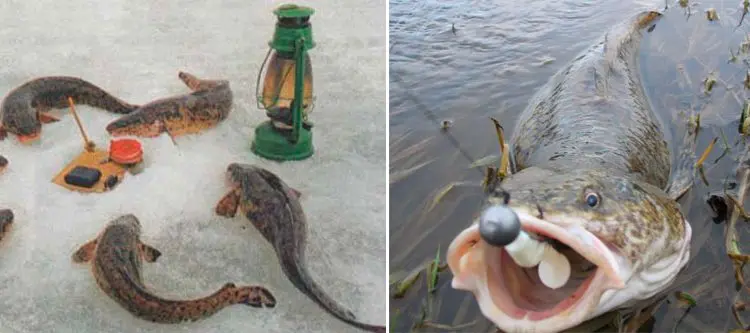
Burbot lives in almost all reservoirs with running and cool water. It grows in length up to 1 meter, gaining weight up to 20 kg. Burbot, like most predators, go out to “hunt” at night. When the water cools to a certain temperature, it can be caught in the daytime. Young individuals are characterized by a darker color, while adults acquire a marbled hue. Burbot meat is very tasty. There are small scales on the body, which is not necessary to clean.
Tackle for winter burbot fishing
Burbot feels great in cold water, when other fish species stop showing their activity and prefer to be at a depth. This fish is most active at water temperatures below 10°C. During periods of real winter cooling, burbot may stop feeding, and will not be caught throughout the entire period of severe frosts. But this can only happen during the spawning period.
Burbot spawns in December-January. During this period, his bite may not be stable, and sometimes even completely absent. Burbot, like other types of fish, has its own paths along which it moves in search of food. On the same paths, he goes to spawn. If you manage to get on this trail, then the catch will be guaranteed. The duration of spawning is determined by 10-15 days. Various tackle is used to catch this fish. As a rule, they are similar to gear for catching other types of fish in the winter, although they have some differences.
Catching burbot on bait
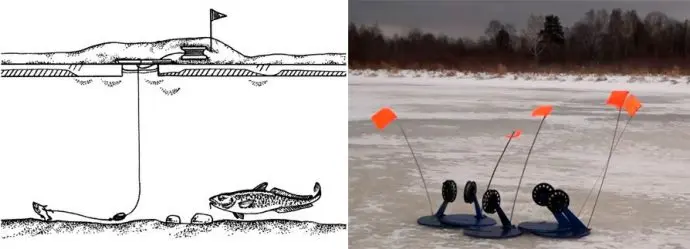
The vents are used for catching predatory fish, such as pike, but other types of predatory fish, including burbot, can also be caught with this tackle. There are two types of girders:
- over-ice;
- subglacial.
The first type of vents are classic ice fishing tackle, and the second type is vents for fishing at very low temperatures, when there is a possibility of freezing the hole. This is especially true in conditions where the vent is left overnight, unattended.
The under-ice vent consists of a wooden stick, to which a flyer made of wood is attached, with a fishing line wound around it, with a diameter of 0,4-0,5 mm. The fishing line is fixed on the flyer in such a way that, when biting, it is released and unwound from the flyer without any problems. The stick rests on the ice across the hole and serves as a kind of stopper for the fishing line. When all the fishing line is unwound from the flyer, it will be held at a certain distance with the help of this stick. At the end of the fishing line there is a load weighing about 40 g. A leash with a hook No. 10 … No. 12 and a length of about 50 cm is attached to the place where the load is attached. The diameter of the line for the leash is selected slightly less than the thickness of the main line (0,3 – 0,35 mm) .
The bait can be a fish (may not be alive), a piece of fish or meat, as well as a bunch of worms that are harvested in the fall.
If the vent is left for the night, then it can freeze in the hole and then you can get the fish only in this way: punch a hole nearby and hook the fishing line with a hook, and then pull the fish through this hole.
The advantage of a zherlitsa is that it can be left overnight and come and check in the morning. To be able to count on the catch, you should install several of these gear. Some fans of winter fishing install dozens of girders. Unfortunately, this approach to fishing can be seen as poaching. In some regions, at the legislative level, the number of installed vents per angler is regulated.
Catching burbot with a “stalker”
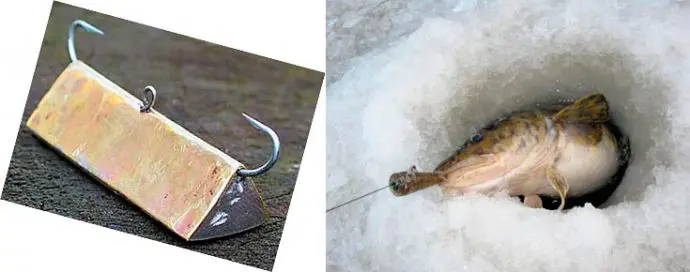
This easy-to-make tackle is quite effective. For its manufacture, it is necessary to prepare a small piece of a metal tube of a round or square section. Hooks are attached to the sides of the workpiece, after which it is filled with lead. The result is a rig that has a certain weight, which will allow you to tap the bottom. At the same time, it should be remembered that the more noise, the more likely it is that burbot will be attracted by this noise, as well as a cloud of turbidity that will appear after tapping the bottom. Other fish, such as pike or zander, are also caught in a similar way.
Bottom tackle for winter fishing
Such a donka consists of a fishing line, 0,4-0,5 mm thick, at the end of which a load is attached. The mass of the sinker depends on the presence and speed of the current. In the same place, you should fasten the leash with a hook. The length of the leash can be in the range of 40-50 cm. The position of the bait is very important: it should be at the bottom.
The use of a balancer for catching burbot
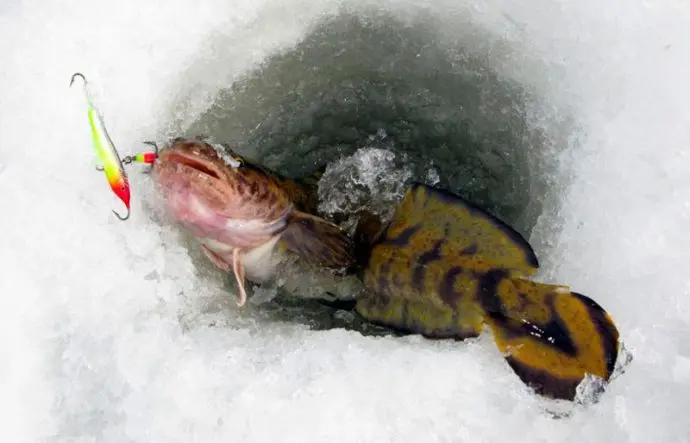
Burbot, like pike perch, leads a bottom lifestyle, therefore, for catching burbot, you can use the same gear as for catching pike perch. As a rule, this is a winter fishing rod with a reel and a hard whip. At least 20 meters of fishing line with a diameter of 0,3 mm is wound on the reel. Balancers, 5-6 cm long, are suitable for catching burbot. When fishing on a balancer, it should be remembered that the entire success of fishing depends on the presence of pauses in the wiring. Pauses between rod swings can reach 7-20 seconds, depending on the activity of the bite.
Tackle for burbot fishing in open water
If in the summer it makes no sense to count on the capture of burbot, then in spring and autumn the capture of burbot is an absolutely real event. During these periods, slightly different gear is used for catching burbot than in winter, although the difference is very arbitrary.
Spring burbot fishing
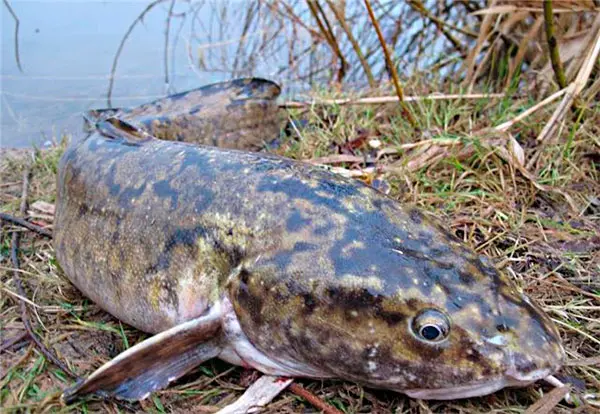
After the ice melts, you can start “hunting” for burbot using various bottom gear. At the same time, the best fishing period is the period before the flood. With the beginning of the flood, the fish spreads over the water area of the reservoir, moreover, it is not so easy to get to the traditional fishing spots. During the flood period, most anglers ignore the process of fishing.
Autumn burbot fishing
Somewhere at the end of April, the biting of burbot stops and resumes only when the water temperature does not reach +10°C. Starting from this moment, burbot can be caught until ice appears on the pond. During this period, burbot prefers to feed on fish or its pieces. In this case, you can use both live and non-live fish. The fishing technique, as well as gear, are the same as for fishing in the spring.
Catching burbot on the donka in the cast
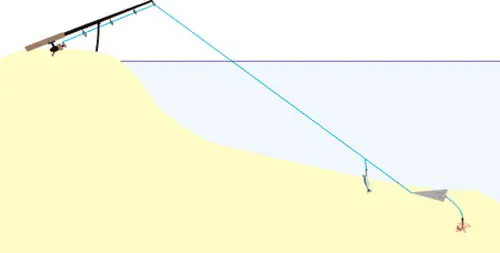
When catching this fish, there is no need for long-range or accurate casting. It is enough to have a powerful and reliable tackle. A cheap Chinese spinning rod with a reel of 3000-4000 sizes is quite suitable. A large spool is needed so that you can easily wind a sufficient amount of fishing line, 0,27-0,3 mm thick.
When catching burbot, you can use any equipment:
- deaf equipment is used for winter fishing;
- sliding equipment, when the load moves freely along the fishing line;
- the use of an anti-twist tube is similar to a feeder rig, but a feeder is not used to catch burbot, but an ordinary load.
The mass of the load is selected depending on the speed of the current. Leashes have a length of no more than 50 cm, and the size of the hooks is chosen from numbers No. 10 … No. 14.
At the end of April, burbot fishing continues, fishing for bottoms, sprat bait and dug worm.
Catching burbot on the “elastic band”
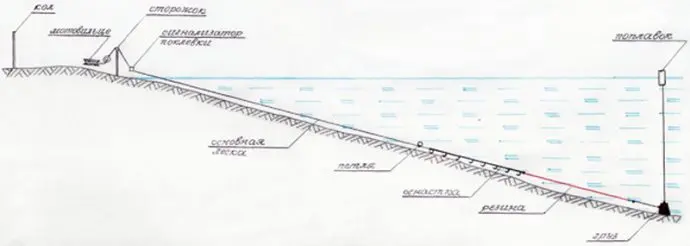
Tackle type “gum” is widely used by anglers when catching various types of fish, including burbot. The advantage of the tackle is that it does not need to be constantly and completely pulled out of the water to check the nozzle. It is enough to pull out one of the hooks, which allows you to make a rubber shock absorber. At the same time, the hooks themselves return to the fishing point, it is enough to let go of the main fishing line. Maximum efficiency with minimal effort and money, these are the characteristic features of such gear. To make an “elastic band” with your own hands, you should stock up on the following elements:
- fishing line, with a diameter of 0,5-0,6 mm and a length of about 50 m;
- a piece of fishing line, with a diameter of 0,4-0,5 mm for attaching leashes with hooks;
- a pair of carabiners for attaching an insert from a fishing line;
- 5-6 swivels for attaching leashes;
- 10 pieces of beads for carabiners stoppers;
- 5 hooks No. 10-No. 14 and 5 leashes;
- 10 meters of aviation gum;
- 1 m of rope for attaching the load to the elastic band;
- load weighing up to 0,5 kg, depending on the casting distance.
If all the parts are assembled, you can begin to form gear. To begin with, a load is taken and tied to a rope. The second end of the rope is attached to an elastic band, which, in turn, is connected to an insert on which leashes with hooks are installed. To prevent the leashes from moving along the fishing line, they are stopped on both sides with beads. Leads are attached to the line with carabiners. In the same way, this insert is connected to the main fishing line and a rubber shock absorber.
Tackle, in assembled form, is wound on a reel. In this state, it is stored and transported. The reel is made in such a way that at one end it can be stuck into the ground on the shore of the reservoir.
Catching burbot with float tackle
When using float gear, it is better to use floats weighing from 10 to 15 g. This is due to the fact that burbot is a strong and energetic fish. As for the fishing line and reel, their dimensions may be similar to those used when fishing with bottom gear.
Bait for catching burbot
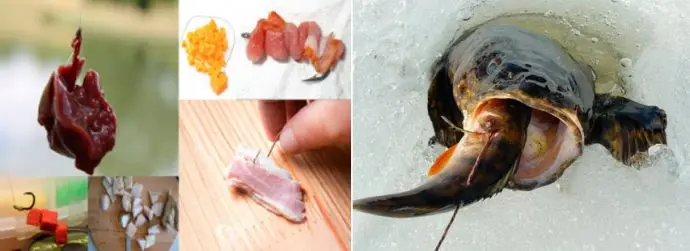
As a rule, only baits of animal origin are suitable for catching burbot, such as:
- fish or pieces of fish;
- worms;
- a bunch of worms;
- frog;
- pieces of meat.
Summer burbot fishing
If the water in the reservoir warms up to a temperature above + 10 ° C, then the burbot hides in snags or in burrows, where it hibernates.
Catching burbot with hands
If you walk along the shore and find crayfish holes, then there is a high probability that they may contain burbot. In this case, it can be caught by hand.
Tackle for fishing burbot — Video
If you watch the video, you can learn a lot of useful information, both on the technique of catching this fish and on the gear used.
Winter gear for burbot
The simplest tackle for catching burbot in winter. Poke.
Tackle for catching burbot in autumn
Burbot – preparation of gear.









